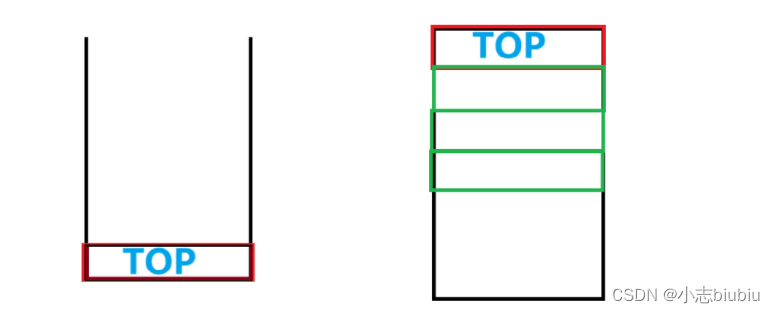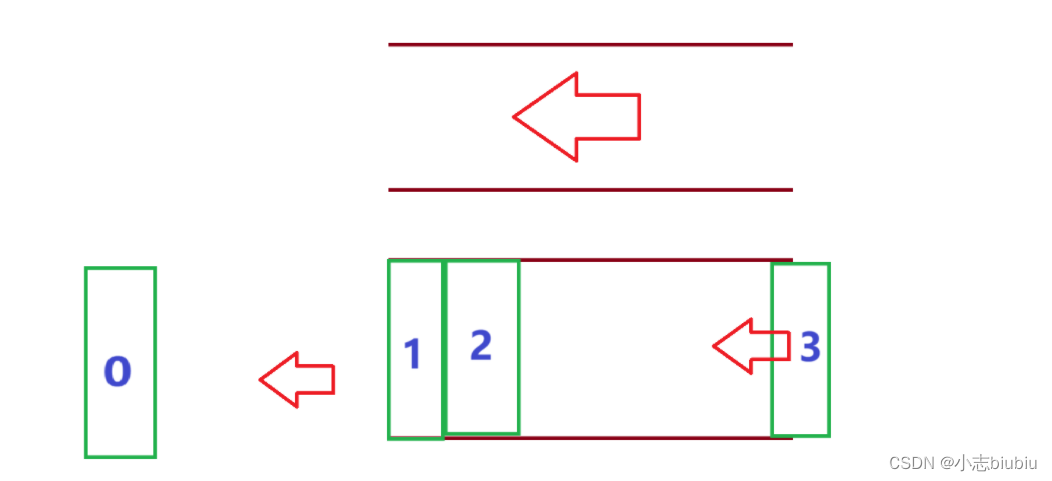引言
在数据结构的学习中,栈(Stack)和队列(Queue)是两个非常重要的概念。它们分别遵循着后进先出(LIFO)和先进先出(FIFO)的原则。在某些情况下,我们可能需要通过栈来模拟队列,或者通过队列来模拟栈的行为。本文将详细介绍这两种数据结构,并提供相应的C语言实现代码和图解。
一、栈(Stack)
栈是一种后进先出(LIFO)的数据结构,只允许在一端进行操作,这一端被称为栈顶(top)。栈的基本操作包括入栈(push)和出栈(pop)。
C语言实现栈:
// 支持动态增长的栈
typedef int STDataType;
typedef struct Stack
{
STDataType* _a;
int _top; // 栈顶
int _capacity; // 容量
}Stack;
// 初始化栈
void StackInit(Stack* ps)
{
assert(ps);
ps->_a = NULL;
//top指向栈顶数据的下一个位置
ps->_top = 0;
//top指向栈顶数据
//ps->_top = -1;
ps->_capacity = 0;
}
// 入栈
void StackPush(Stack* ps, STDataType data)
{
assert(ps);
if (ps->_top == ps->_capacity)
{
int newcapacity = ps->_capacity == 0 ? 4 : ps->_capacity * 2;
STDataType* tmp = (STDataType*)realloc(ps->_a, newcapacity * (sizeof(STDataType)));
if (tmp == NULL)
{
perror("realloc fail");
return;
}
ps->_a = tmp;
ps->_capacity = newcapacity;
}
ps->_a[ps->_top] = data;
ps->_top++;
}
// 出栈
void StackPop(Stack* ps)
{
assert(ps);
assert(ps->_top > 0);
ps->_top--;
}
// 获取栈顶元素
STDataType StackTop(Stack* ps)
{
assert(ps);
assert(ps->_top > 0);
return ps->_a[ps->_top - 1];
}
// 获取栈中有效元素个数
int StackSize(Stack* ps)
{
assert(ps);
return ps->_top;
}
// 检测栈是否为空,如果为空返回非零结果,如果不为空返回0
int StackEmpty(Stack* ps)
{
assert(ps);
assert(ps);
return ps->_top == 0;
}
// 销毁栈
void StackDestroy(Stack* ps)
{
assert(ps);
free(ps->_a);
ps->_a = NULL;
ps->_top = ps->_capacity = 0;
}栈的图解:
(可以想象一个竖直的容器,新元素从顶部加入,也是从顶部取出。)

二、队列(Queue)
队列是一种先进先出(FIFO)的数据结构,只允许在两端进行操作,一端为队头(front),另一端为队尾(rear)。队列的基本操作包括入队(enqueue)和出队(dequeue)。C语言实现队列:
#include <stdio.h>
#include <stdlib.h>
#define MAX_SIZE 100
typedef struct
{
int data[MAX_SIZE];
int front, rear;
} Queue;
void initQueue(Queue *q)
{
q->front = q->rear = -1;
}
int isFull(Queue *q)
{
return (q->rear + 1) % MAX_SIZE == q->front;
}
int isEmpty(Queue *q)
{
return q->front == -1;
}
void enqueue(Queue *q, int value)
{
if (!isFull(q))
{
q->data[++q->rear] = value;
}
else
{
printf("Queue is full!\n");
}
}
int dequeue(Queue *q)
{
if (!isEmpty(q))
{
int value = q->data[q->front++];
if (q->front > q->rear) q->front = q->rear = -1; // 处理队列为空的情况
return value;
} else
{
printf("Queue is empty!\n");
return -1;
}
}
// ... 其他队列操作函数 ...队列的图解:
(可以想象一个水平的容器,新元素从尾部加入,从头部取出。)

三、循环队列
循环队列是对普通队列的一种改进,通过取模运算实现队首和队尾的循环,从而更高效地利用存储空间。相当于队列头尾相接,同时容量固定.
(代码与上面的队列实现类似,主要区别在于isFull和isEmpty的判断,以及front和rear的更新方式。)
#include <stdio.h>
#include <stdlib.h>
#include <stdbool.h>
#include <assert.h>
typedef struct
{
int* a;
int head; //指向头
int tail; //指向尾下一个
int k; //容量
} MyCircularQueue;
MyCircularQueue* myCircularQueueCreate(int k)
{
MyCircularQueue* obj = (MyCircularQueue*)malloc(sizeof(MyCircularQueue));
if (obj == NULL)
{
return;
}
//多开一个解决假溢出问题
obj->a = (int*)malloc(sizeof(int)*(k + 1));
obj->head = 0;
obj->tail = 0;
obj->k = k;
return obj;
}
bool myCircularQueueIsEmpty(MyCircularQueue* obj)
{
return obj->head == obj->tail;
}
bool myCircularQueueIsFull(MyCircularQueue* obj)
{
return (obj->tail + 1) % (obj->k + 1) == obj->head;
}
bool myCircularQueueEnQueue(MyCircularQueue* obj, int value)
{
if (myCircularQueueIsFull(obj))
{
return false;
}
obj->a[obj->tail] = value;
obj->tail++;
obj->tail %= (obj->k + 1);
return true;
}
bool myCircularQueueDeQueue(MyCircularQueue* obj)
{
if (myCircularQueueIsEmpty(obj))
{
return false;
}
++obj->head;
obj->head %= (obj->k + 1);
return true;
}
int myCircularQueueFront(MyCircularQueue* obj)
{
if (myCircularQueueIsEmpty(obj))
{
return -1;
}
else
{
return obj->a[obj->head];
}
}
int myCircularQueueRear(MyCircularQueue* obj)
{
if (myCircularQueueIsEmpty(obj))
{
return -1;
}
else
{
return obj->a[(obj->tail + obj->k) % (obj->k + 1)];
}
}
void myCircularQueueFree(MyCircularQueue* obj)
{
free(obj->a);
free(obj);
}四、栈实现队列
虽然栈是后进先出的数据结构,但我们可以通过两个栈(一个作为输入栈,一个作为输出栈)来模拟队列的先进先出特性。
代码实现:
(主要涉及两个栈的push和pop操作,以及如何在适当的时候交换两个栈的角色。)
// 支持动态增长的栈
typedef int STDataType;
typedef struct Stack
{
STDataType* _a;
int _top; // 栈顶
int _capacity; // 容量
}Stack;
// 初始化栈
void StackInit(Stack* ps)
{
assert(ps);
ps->_a = NULL;
//top指向栈顶数据的下一个位置
ps->_top = 0;
//top指向栈顶数据
//ps->_top = -1;
ps->_capacity = 0;
}
// 入栈
void StackPush(Stack* ps, STDataType data)
{
assert(ps);
if (ps->_top == ps->_capacity)
{
int newcapacity = ps->_capacity == 0 ? 4 : ps->_capacity * 2;
STDataType* tmp = (STDataType*)realloc(ps->_a, newcapacity * (sizeof(STDataType)));
if (tmp == NULL)
{
perror("realloc fail");
return;
}
ps->_a = tmp;
ps->_capacity = newcapacity;
}
ps->_a[ps->_top] = data;
ps->_top++;
}
// 出栈
void StackPop(Stack* ps)
{
assert(ps);
assert(ps->_top > 0);
ps->_top--;
}
// 获取栈顶元素
STDataType StackTop(Stack* ps)
{
assert(ps);
assert(ps->_top > 0);
return ps->_a[ps->_top - 1];
}
// 获取栈中有效元素个数
int StackSize(Stack* ps)
{
assert(ps);
return ps->_top;
}
// 检测栈是否为空,如果为空返回非零结果,如果不为空返回0
int StackEmpty(Stack* ps)
{
assert(ps);
assert(ps);
return ps->_top == 0;
}
// 销毁栈
void StackDestroy(Stack* ps)
{
assert(ps);
free(ps->_a);
ps->_a = NULL;
ps->_top = ps->_capacity = 0;
}
//leetcode
typedef struct
{
Stack pushst;
Stack popst;
} MyQueue;
MyQueue* myQueueCreate()
{
MyQueue* obj = (MyQueue*)malloc(sizeof(MyQueue));
if (obj == NULL)
{
return;
}
StackInit(&(obj->popst));
StackInit(&(obj->pushst));
return obj;
}
void myQueuePush(MyQueue* obj, int x)
{
StackPush(&(obj->pushst), x);
}
int myQueuePeek(MyQueue* obj)
{
if (StackEmpty(&(obj->popst)))
{
//倒数据
while (!StackEmpty(&(obj->pushst)))
{
int top = StackTop(&(obj->pushst));
StackPush(&(obj->popst), top);
StackPop(&(obj->pushst));
}
}
return StackTop(&(obj->popst));
}
int myQueuePop(MyQueue* obj)
{
int front = myQueuePeek(obj);
StackPop(&(obj->popst));
return front;
}
bool myQueueEmpty(MyQueue* obj)
{
return StackEmpty(&(obj->popst)) && StackEmpty(&(obj->pushst));
}
void myQueueFree(MyQueue* obj)
{
StackDestroy(&(obj->popst));
StackDestroy(&(obj->pushst));
free(obj);
}五、队列实现栈
队列是先进先出的数据结构,但通过两个队列(或者一个队列和一个辅助栈)也可以模拟栈的后进先出特性。
代码实现:
typedef char QDataType;
typedef struct QueueNode
{
struct QueueNode* next;
QDataType val;
}QNode;
typedef struct Queue
{
QNode* phead;
QNode* ptail;
int size;
}Queue;
void QueueInit(Queue* pq)
{
assert(pq);
pq->phead = NULL;
pq->ptail = NULL;
pq->size = 0;
}
void QueueDestroy(Queue* pq)
{
assert(pq);
QNode* cur = pq->phead;
while (cur)
{
QNode* next = cur->next;
free(cur);
cur = next;
}
pq->phead = pq->ptail = NULL;
pq->size = 0;
}
// 队尾插入
void QueuePush(Queue* pq, QDataType x)
{
assert(pq);
QNode* newnode = (QNode*)malloc(sizeof(QNode));
if (newnode == NULL)
{
perror("malloc fail");
return;
}
newnode->next = NULL;
newnode->val = x;
if (pq->ptail == NULL)
{
pq->phead = pq->ptail = newnode;
}
else
{
pq->ptail->next = newnode;
pq->ptail = newnode;
}
pq->size++;
}
// 队头删除
void QueuePop(Queue* pq)
{
assert(pq);
assert(pq->size != 0);
/*QNode* next = pq->phead->next;
free(pq->phead);
pq->phead = next;
if (pq->phead == NULL)
pq->ptail = NULL;*/
// 一个节点
if (pq->phead->next == NULL)
{
free(pq->phead);
pq->phead = pq->ptail = NULL;
}
else // 多个节点
{
QNode* next = pq->phead->next;
free(pq->phead);
pq->phead = next;
}
pq->size--;
}
QDataType QueueFront(Queue* pq)
{
assert(pq);
assert(pq->phead);
return pq->phead->val;
}
QDataType QueueBack(Queue* pq)
{
assert(pq);
assert(pq->ptail);
return pq->ptail->val;
}
int QueueSize(Queue* pq)
{
assert(pq);
return pq->size;
}
bool QueueEmpty(Queue* pq)
{
assert(pq);
return pq->size == 0;
}
typedef struct
{
Queue q1;
Queue q2;
} MyStack;
//leetcode
MyStack* myStackCreate()
{
MyStack* pst = (MyStack*)malloc(sizeof(MyStack));
QueueInit(&(pst->q1));
QueueInit(&(pst->q2));
return pst;
}
void myStackPush(MyStack* obj, int x)
{
if (!QueueEmpty(&(obj->q1)))
{
QueuePush(&(obj->q1), x);
}
else
{
QueuePush(&(obj->q2), x);
}
}
int myStackPop(MyStack* obj)
{
//假设法
Queue* empty = &(obj->q1);
Queue* nonempty = &(obj->q2);
if (!QueueEmpty(&(obj->q1)))
{
nonempty = &(obj->q1);
empty = &(obj->q2);
}
//不为空前size-1导走,删除最后一个就是栈顶数据
while (QueueSize(nonempty) > 1)
{
QueuePush(empty, QueueFront(nonempty));
QueuePop(nonempty);
}
int top = QueueFront(nonempty);
QueuePop(nonempty);
return top;
}
int myStackTop(MyStack* obj)
{
if (!QueueEmpty(&(obj->q1)))
{
return QueueBack(&(obj->q1));
}
else
{
return QueueBack(&(obj->q2));
}
}
bool myStackEmpty(MyStack* obj)
{
return QueueEmpty(&(obj->q1)) && QueueEmpty(&(obj->q2));
}
void myStackFree(MyStack* obj)
{
QueueDestroy(&(obj->q1));
QueueDestroy(&(obj->q2));
free(obj);
}分享到这里,欢迎翻阅我的文章.






















 794
794











 被折叠的 条评论
为什么被折叠?
被折叠的 条评论
为什么被折叠?










